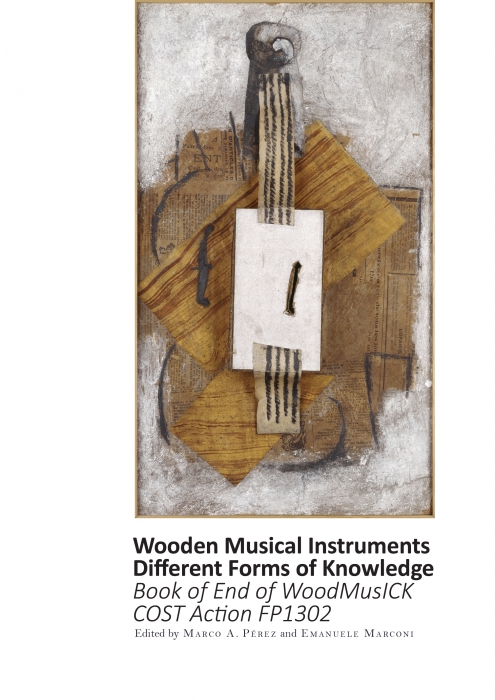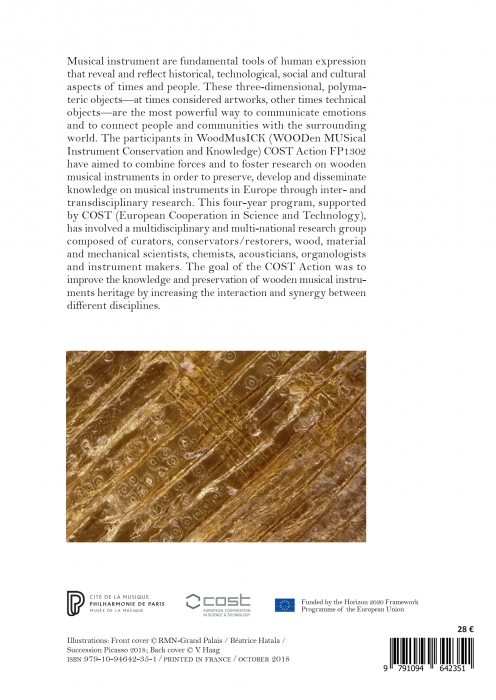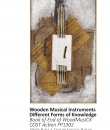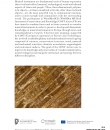Wooden Musical Instruments Different Forms of Knowledge
Book of End of WoodMusICK COST Action FP1302
Présentation
Musical instrument are fundamental tools of human expression that reveal and reflect historical, technological, social, and cultural aspects of times and people. These three-dimensional, polymateric objects, at times considered artworks, other times technical objects, are the most powerful way to connect people and communities with the surrounding world and communicate emotions.
WoodMusICK (WOODen MUSical Instrument Conservation and Knowledge) FP1302 COST Action have aimed to combine forces and to foster research on wooden musical instruments in order to preserve, develop and disseminate knowledge on musical instruments in Europe through an inter- and transdisciplinary research. This four-year program, supported by COST (European Cooperation in Science and Technology), has involved a multi-disciplinary and multi-national research group composed by curators, conservators/restorers, wood, material and mechanical scientists, chemists, acousticians, organologists as well as instrument makers. The goal of the COST Action was to improve the knowledge and preservation of the wooden musical instruments heritage by increasing the interaction and synergy between different disciplines.
Musical instrument are fundamental tools of human expression that reveal and reflect historical, technological, social, and cultural aspects of times and people. These three-dimensional, polymateric objects, at times considered artworks, other times technical objects, are the most powerful way to connect people and communities with the surrounding world and communicate emotions.
WoodMusICK (WOODen MUSical Instrument Conservation and Knowledge) FP1302 COST Action have aimed to combine forces and to foster research on wooden musical instruments in order to preserve, develop and disseminate knowledge on musical instruments in Europe through an inter- and transdisciplinary research. This four-year program, supported by COST (European Cooperation in Science and Technology), has involved a multi-disciplinary and multi-national research group composed by curators, conservators/restorers, wood, material and mechanical scientists, chemists, acousticians, organologists as well as instrument makers. The goal of the COST Action was to improve the knowledge and preservation of the wooden musical instruments heritage by increasing the interaction and synergy between different disciplines.
Table des matières
Foreword, Sandie Le Conte
- Instrument (Re-)construction as a Catalyst for Organological Research, Geerten Verberkmoes
- Material or Immaterial? A Questionnaire to Help Decisions About the Preservation of Musical Instruments, Vera de Bruyn-Ouboter
- Adopting a Policy of Faithful Copies of Historically Important Musical Instruments as an Alternative to Restoration, John Ray, Antonio Manjón, Aaron García
- Methods of Dendrochronology for Musical Instruments, Mauro Bernabei, Katarina Cufar
- Tropical and Traditional Wood Species in Musical Instruments and Case Studies of Their Substitution with Modified Wood Mario Zauer, Alexander Pfriem
- Assessing the Impact of Conservation Materials on the Acoustic Properties of Woodwind Musical Instruments, Efstathios Doganis, Sandie Le conte, Anastasia Pournou
- Revisiting the Notion of “Resonance Wood” Choice: A Decompartmentalised Approach, from Violin-Makers’ Opinion and Perception to Characterization of Material Properties’ Variability, C. Carlier, A. Alkadri, J. Gril, I. Brémaud
- Non-Destructive Investigation of Historical Instruments Based on 3D-Reflected-Light Microscopy and High-Resolution μ-X-ray CT, Volker Haag, Sebastian Kirsch, Gerald Koch, Valentina Zemke, Hans-Georg Richter
- X-Ray CT and Neutron Imaging for Musical Instruments A Comparative Study, Sebastian Kirsch, David Mannes
- Three-Dimensional Computed Tomography Scanning of Musical Instruments, Frank P. Bär, Theobald Fuchs, Sebastian Kirsch, Rebecca Wagner, Gabriele Scholz, Christian Kretzer, Richard Schielein, Guido Brennhäusser, Michael Böhnel, Nils Reims, Markus Eberhorn, Tobias Koppers, Markus Raquet, Meike Wolters-Rosbach, Kathrin Fischeidl, Sarah Wagner, Markus Zepf
- Application of X-Ray Computed Tomography in Diagnostics and Reverse Engineering of Bowed Stringed Musical Instruments, F. Piasentini, M. Moscatti, S. Carmignato
- Geometrical Analysis on the Design of Stringed Instruments – A Useful Method for Luthiers and Musicologists? Simone Regina Zopf, Florian Hertzsch, Manuel Hrovath, Jakob Nachbargauer, Andreas Seyer-Klicznik
- Sibire’s Aesthetic Sensibility: Stradivarius, the Classical Ideal and a New Noble Purpose, Christina Linsenmeyer
- The Acoustics and Historic Development of String Instruments, George Stoppani, Colin Gough
- Violins, Pochettes, or Mute violins? Shining a Light on the “Violins Without Sides”, J. Santa Maria Bouquet, S. Kirsch, M. Albano, A. Rigamonti
- Virtual Experiments on Stringed Wooden Instruments: Influence of Mechanical and Climate Loading, Daniel Konopka, Michael Kaliske
- Restoration of the Mother-and-Child Virginal by Ioannes Ruckers (Antwerp, 1610): The Choice of a New Presentation With a Focus on the Difficult Problem of Soundboard Cleaning, Agnès Esquirol, Livine Huart, Cécile de Boulard
- FA-RE-MI (Faire parler les instruments de musique du patrimoine): Making Historical Musical Instruments Speak, Stéphane Vaiedelich, H. Boutin, Arthur Paté, A. Givois, B. Fabre, S. Le Conte, J. -L. LeCarrou
- Early Development Process of the Steinway & Sons Grand Piano Duplex Scale, Niko Plath, Katharina Preller
- A Synergy of Form, Function and Fashion in the Manufacture of the Erard Harp, Panagiotis Poulopoulos, Julin Lee
- The Music of the Mulberry: Wood Science, Know-How and Symbolism in Instrument-Making in Khorassan (Iran) and Central Asia, Farrokh Vahabzadeh




